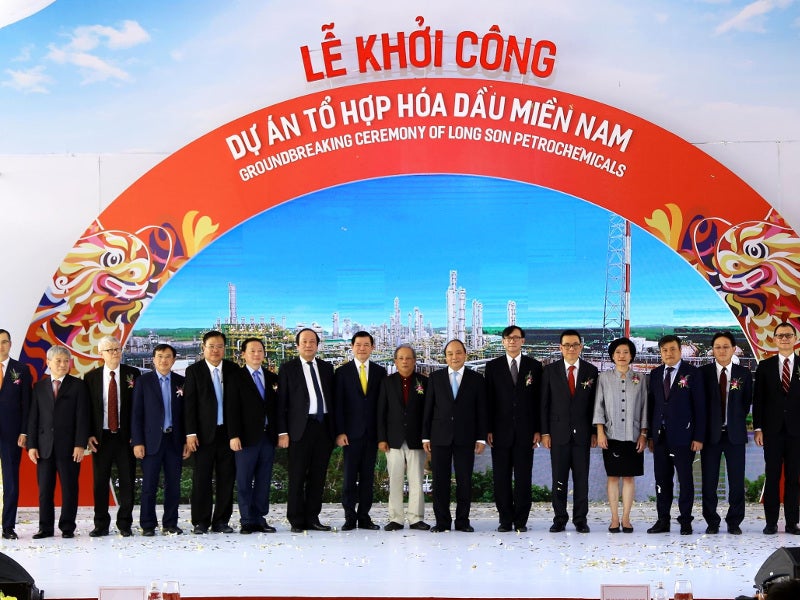SCC’s Vietnam-based Long Son project Background In 2008, SCC announced that its plan to invest in a new petrochemical complex in Vietnam was under feasibility study.
In Feb 2012, SCC signed a joint venture agreement with Qatar Petroleum International Vietnam (QPI) and PetroVietnam (wholly owned by the Vietnamese government) to invest in Longson Petrochemical Company (LSP) with the aim to construct a mixed-feed olefins cracker with downstream facilities. Originally, SCC held 46% stake while QPI and PetroVietnam held 25% and 29% stakes, respectively. In Mar 2017, SCC announced to SET that it signed a share purchase agreement with QPI to acquire 25% equity stake in LSP.
According to QPI, the company pulled out from the project due to its revised capital and feedstock allocation strategies. Post transaction, SCC’s total stake in LSP increased to 1% from 46% previously. In May 2018, PetroVietnam sold its 29% stake to SCC for THB2.9bn. SCC said at the time that the investment privileges from Vietnamese government were intact. Post the transaction, SCC held 100% of LSP. The total project cost is US$5.5bn.
A loan agreement for US$3.2bn with a 14- year tenor was signed with syndicated lenders in 3Q18. The implied D/E ratio is 1.5:1. The construction started in 4Q18. Key contractors included the consortium of Technip and SK E&C, POSCO E&C, Samsung Engineering, and Hyundai Engineering. According to SCC, the project was 66% completed at end-2020 and should be able to start commercial operations within 1H23. Project details LSP project is located in Vung Tao province (100km from Ho Chi Minh City).
The estimated capacity is 1.65mt of olefins (the proportion of ethylene vs. propylene would depend on feedstock type), 1.35mt of downstream PE/PP and other byproducts (benzene, toluene, crude C4). SCC said the cracker is designed to have high flexibility to use gas (ethane and LPG) up to 80% of total feedstock requirement. SCC said QPI agreed to remain the LPG supplier despite its decision to pull out from the JV. Ethane feedstock (max at 10% of requirement) will be provided by PetroVietnam. SCC signed a 15-year feedstock contract (2mtpa of LPG and naphtha) with QPI in 2Q18
Project IRR hinges on cost competitiveness of feedstock We believe the profitability and IRR of LSP hinge largely on the mix of feedstock and the cost of LPG that SCC and QPI agreed under the long-term contract. Based on our estimates, LPG usage at 60% of total feedstock requirement is the optimal level that would maximise annual EBITDA and net profit for the project, assuming that LPG cost under QPI agreement is sold at a 30% discount to the market price of naphtha.
Assuming that HDPE-naphtha and PP-naphtha spreads are at US$500/t and US$520/t respectively, we estimate that EBITDA accretion from LSP is THB12.0bn. If LPG is sold at a 20% discount to naphtha market price, EBITDA accretion would be lower at THB10.7bn.
Assuming D/E ratio of 1.5:1 and HDPE-naphtha spread of US$550/t, we estimate that the project should achieve an IRR of 11.0% if the project cost is at US$5.5bn. Assuming 15% cost overruns, project IRR could reduce to 9.5%, based on our estimates.
Near-term catalyst from strong chemical spreads; Reiterate Add on SCC and PTTGC We believe the strength in Asian PE-naphtha and PP-naphtha spreads seen during 1Q21 should continue into 2Q21F as Asian polymer supply should remain tight despite the better availability of containers which was one of the key hurdles for US exports.
According to IHS Markit, PE/PP inventory levels fell to less than 34 days and 21 days, respectively, as of Mar 21, lower than historical levels of 36-42 days and 28-30 days. Toyota Motor Corp and Honda Motor Co., Ltd cut auto production in the US in Jan 21, partly due to the shortage of plastic resins (multiple plant shutdowns). With the unmet domestic demand, US-based PE producers are likely to limit export cargoes to Asia, in our view. According to IHS Markit, it would take more than 9 months for US producers to recover the lost production, assuming that average utilisation rate is 95%.
In Asia, the planned and unplanned shutdowns of ethylene capacity in 2Q21F are relatively lower than in 2Q20 but higher than in 1Q21, based on IHS estimates. The unplanned shutdown of LG Chemical in Daesan in late-Mar 21 has already been resolved. The slower utilisation rates of downstream ethylene derivatives and weaker demand ahead of the Ramadan season are the key short-term risks to Asian ethylene/propylene prices but we believe that average ethylene and propylene utilisation rates would remain higher than 90% in 2021F.
Apart from the PE/PP strength, other chemical value chains are also showing rising spreads. For SCC, the strength in polyvinyl chloride (PVC) – ethylene dichloride (EDC) spread should also support its chemical EBITDA in 2021F. Strong demand in the US, India and Asia should continue to support PVC selling prices while Chinese coal-based PVC producers should remain at a cost disadvantage compared to ethylene-based producers like SCC. We note that integrated PVC producers (with caustic soda by-product) like Vinythai (currently 25% owned by PTTGC) should fare even better than non-integrated players.
For PTTGC, the strong surge in phenol and Bis-phenol A spreads will support chemical EBITDA in 2021F, in our view. In addition, the strong demand in the downstream acrylic fiber market continued to drive acrylonitrile (AN) prices in Mar 21.
We believe IRPC should benefit from the strong acrylonitrile-styrene-
– By CIMB Bank Research


